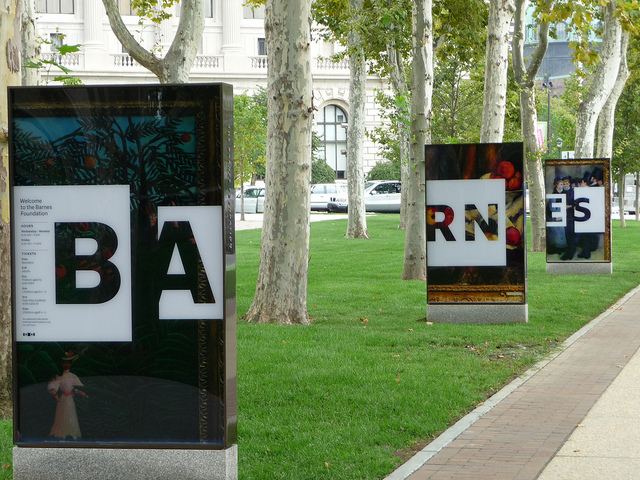
Approaching the Barnes Foundation. Photo © Art Poskanzer, licensed Creative Commons Attribution.
Philadelphia’s Museum District is home to several worthwhile sights including the Franklin Institute, a museum dedicated to one of the major focuses of Ben Franklin’s life work—expanding knowledge of the universe through science.
A skeleton replica of a 42-foot-long, 7.5-ton Tyrannosaurus rex smiling with razor-sharp teeth greets guests upon entering the Academy of Natural Sciences (1900 Benjamin Franklin Pkwy., 215/299-1000; Mon.-Fri. 10am-4:30pm, Sat.-Sun. 10am-5pm; $15 adult (over 13), $13 child (3-12), senior, military, and student, free under 3, additional fee for special exhibits). From dinosaurs to apes to tigers, the exhibits take visitors through evolutionary history from the Mesozoic era to present day, capturing animal life across the planet in glass-enclosed, realistic-looking habitat displays. Children love to take part in real archaeological digs and to see the live animal exhibits.
Eccentric art collector Albert C. Barnes probably never could have imagined his little art collection would cause such trouble. His legacy, the Barnes Foundation (2025 Benjamin Frankin Pkwy., 215/278-7000; Wed.-Mon. 10am-6pm; $18 adult, $15 senior, $10 student and youth (6-18), free child 5 and under), is an awesome multibillion-dollar collection of Impressionist and Expressionist works by Cézanne, Gauguin, El Greco, Goya, Manet, Matisse, Modigliani, Monet, Picasso, Renoir, and Van Gogh, along with impressive African sculptures and much, much more. Cosseted away at Barnes’s former estate in the Philadelphia suburbs of Merion since the 1920s,the collection was embroiled in a lengthy battle over whether to move to a more accessible Center City location. Some of the same suburban neighbors who complained about visitor traffic fought for it to stay once they realized they might lose it, while Philadelphia city officials have longed to acquire it for the city for the revenue and tourism it attracts.
After much debate, it was finally decided in court that the museum would move to the Benjamin Franklin Parkway. In 2012, the Barnes Foundation reopened on the Museum District corridor that is home to many of Philadelphia’s other top museums, including the Philadelphia Museum of Art, the Franklin Institute, Academy of Natural Sciences, and the Rodin Museum. The design team meticulously rebuilt the museum to reflect Barnes’s original curation, from the paint colors to the placement of every work of art. This world-class collection is a must-see, not just for the art, but for the unique vision the Barnes Foundation imparts. Anyone interested in learning more about the battle over the Barnes can watch Art of the Steal, an interesting documentary about the collection and Albert Barnes himself, a fascinating man who made a fortune on a medical invention and spent most of it creating one of the world’s best collections of art.
Scientist and inventor Benjamin Franklin would be proud of the impressive museum named for him and dedicated to one of the major focuses of his life work—expanding knowledge of the universe through science. A larger-than-life statue of Ben welcomes guests into the grand high-ceilinged lobby of the Franklin Institute (222 N. 20th St., 215/448-1200; daily 9:30am-5pm; $16.50 adult, $15.50 senior and military, $12.50 child (4-11), free under 4, additional fee for IMAX or Franklin Theater and other special exhibits). The large museum showcases many of Franklin’s own inventions along with countless technological and scientific advances through history with interactive exhibits that are often as interesting and educational for adults as they are for children.
Visitors can explore the engine room of a real 19th-century locomotive, walk through a massive replica of the human heart, and take in the vast expanse of the cosmos in the “Space Command” exhibit. The institute hosts the world’s best traveling science exhibits in addition to ever-expanding permanent displays. A planetarium show is included with the price of admission. One of the best surround-style IMAX theaters in the country and a 3-D theater (the Franklin Theater) round out the museum’s diverse offerings, and admission can be added to a museum ticket or purchased for a separate fee if visited individually.
Many will recognize Auguste Rodin’s famous sculpture The Thinker, which welcomes visitors into the museum dedicated entirely to the French artist’s work. Walk past the garden and fountain to see many of his other masterpieces, including The Gates of Hell framing the main entrance of the impressive building. Wander through the high-ceilinged, marble-floored rooms and you’ll be amazed by Rodin’s endless true-to-life sculptures of the human body—he was especially skilled at and obsessed with creating human hands. Exhibiting one of the largest Rodin collections in the world, the small but lovely Rodin Museum (22nd St. and Benjamin Franklin Pkwy., 215/568-6026; Tues.-Sun. 10am-5pm; $8 donation suggested) provides an in-depth look at not only his work but also his thought processes and his life. Some of his original tools, early sketches, and journals are on display.
Excerpted from the Third Edition of Moon Philadelphia.